A new tack on raves and drugs [updated]
November 9, 2010
At 63, John Viernes admittedly didn’t blend into the crowd. For one thing, he was wearing more clothes.
But there he was, director of Los Angeles County’s substance abuse and prevention office, positioned at the entrance of the Sports Arena, handing out 3-by-5 cards about the drug Ecstasy to the throngs at last month’s Monster Massive electronic music festival.
“This is really cool,” Viernes says he was told by a number of concertgoers, who actually kept the material. That included the scantily clad girl who gave him a high-five.
The cards—among dozens of recommendations offered this week by a task force on “rave” safety—represent a departure of sorts for the public health department as it experiments with a more credible way to connect with and influence its target audience.
The glossy, colorful cards carry the inherent message that public health officials know that some concertgoers are going to take Ecstasy and want to help them “minimize potential harms” by offering guidance on, among other things, the signs of an overdose, how to keep properly hydrated and the potentially lifesaving importance of keeping doses low and infrequent.
Viernes said some attendees seemed taken aback by the county’s open-minded approach. “I told them to read all the way to the bottom,” Viernes says, where the cards (which were funded by concert promoters) state: “The only way to completely avoid the risks is to avoid the drug, enjoy the music and dancing instead.”
Since the overdose death last summer of a 15-year-old girl who’d attended the annual Electric Daisy Carnival at the Coliseum, these huge electronic music festivals have come under intense scrutiny from health and public safety officials. Emergency room doctors have said that they prepare for concert nights as they would for such “multi-casualty incidents” as earthquakes because of the number of Ecstasy overdoses. Some critics called for an outright ban of raves at public venues, which reap considerable income from renting their facilities to concert promoters.
In the wake of the Electric Daisy Carnival, which drew a stunning 185,000 people during its two-day run in June, the Board of Supervisors unanimously approved a motion by Supervisors Zev Yaroslavsky and Don Knabe to create a task force comprised of public and private sector representatives to take a deeper look at the issues and come up with ways to enhance safety and educate the public on the perils of Ecstasy, a synthetic amphetamine that has become the drug of choice among a growing number of young teens.
In fact, last year the Los Angeles Unified School District sent an “information alert” to principals warning of a “sharp rise in the incidents of ecstasy use in our middle schools and high schools” that led some campuses “to call paramedics for students passed out at school.”
On Monday, the task force submitted to the board 42 recommendations encompassing such areas as emergency medical services, health precautions, law enforcement activities, alcohol policies, venue restrictions and public education campaigns. Participants, including concert promoters, have praised the effort for getting everyone in the same room and giving the issue the high priority that it deserves.
In a statement, a spokesman for Electric Daisy Carnival promoter Insomniac said: “We look forward to implementing these recommendations, in conjunction with Insomniac’s existing safety and security measures, to enhance the safety of events throughout the county while preserving the quality and fun of music fans’ experience.”
Already, some of the recommendations have been piloted at two festivals at the Sports Arena, where the crowds are a fraction of those at the Coliseum. Perhaps most significant for the moment, no one under 18 was allowed to attend the events and a medical station with a physician and nursing staff was set up inside the venue.
Cathy Chidester, director of the county’s emergency medical services agency, says the medical station eliminated the need for many people to be transported to overburdened emergency rooms, a significant change from the past.
Chidester, who attended the last two raves at the Sports Arena, says roving paramedics and emergency medical technicians brought a variety of ailing concertgoers to the physician, most of whom were “slightly altered and needed to be watched until the drug levels [in their systems] went down.” In the past, she says, these people would be transported to hospitals.
Meanwhile, outside the arena, another substantial change had taken root: the number of Los Angeles Police officers deployed in the parking lot had soared to 450 from the 250 assigned to the Coliseum’s Electric Daisy Carnival.
LAPD Deputy Chief Patrick Gannon says most everyone on the task force wanted to keep the raves alive so people could enjoy themselves. “But I don’t want to sanction a drug party either,” says Gannon, who is not happy about using officers “who are normally patrolling the streets of South L.A.”. The goal, he says, is to deter gate crashers and try to shut down drug sales outside so it becomes less problematic on the inside.
Because of the burden on the system, Gannon says he thinks concert promoters should be forced to pick up the tab. “I’ve had conversations with Councilman [Bernard] Parks. We don’t come close to agreeing.” Gannon says the former LAPD chief “thinks I over-deploy. I respectfully disagree. It’s been a long time since he’s deployed officers.”
Parks says he does, in fact, believe that deployment levels at the electronic music festivals have been disproportionate to the problems. He says Gannon’s desire to dry up parking lot drug sales is commendable. “But he should probably call in the Sheriff’s Department, the National Guard and the military if that’s his goal. There’s been drug usage at concerts since before his birth.”
Parks says that festival promoters at the Coliseum and Sports Arena should not be forced to pay for unnecessary officers outside the facility. “The fact that they [LAPD] have chosen to over deploy is on their dime not the dime of the promoter.”
Meanwhile, work continues on the educational component of the campaign. A public service announcement on the dangers of Ecstasy is being prepared for airing at venues and possibly on ticket services.
Financed by promoters, it’ll include such big-name DJ’s as Will.i.am and Tommie Sunshine, who looks into the camera and says: “Rolling on Ecstasy can cause heart problems, brain damage, stroke and possibly death.”
The task force, led by Public Health Director Dr. Jonathan E. Fielding, is asking the Board of Supervisors to adopt the recommendations as “general policy direction” for electronic music festivals countywide and to encourage promoters and sponsoring entities to get on board, too.
Posted 11/9/10
Updated 12/7/10: The Board of Supervisors, acting on a second motion by Supervisors Yaroslavsky and Knabe, unanimously adopted the task force’s key recommendations as general policy direction for all electornic music festivals in Los Angeles County. Those key recommendations include, among other things, ensuring the presence of onsite medical and health personnel, requiring attendees to be 18 or older, creating a threat assessment and action plan for each event and distributing harm reduction materials to concertgoers.
The board also directed the Department of Public Health to report back by the end of September, 2011, with an evaluation of the succcess or failure of health and safety measures implemented at all major electronic music festivals in L.A. County between June of this year and August, 31, 2011.
L.A.’s diabetes epidemic gets worse
November 4, 2010
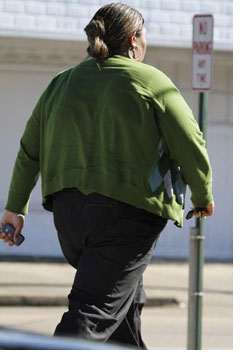 Diabetes in Los Angeles has hit an all-time high, with a new public health report showing that 9.1% of adults have Type 2 diabetes, which usually is caused by obesity.
Diabetes in Los Angeles has hit an all-time high, with a new public health report showing that 9.1% of adults have Type 2 diabetes, which usually is caused by obesity.
The report covers the years from 1997, when the figure was 6.6%, to 2007.
“It is unacceptable that so many people are suffering from a disease that, in most cases, can be prevented or controlled,” said Dr. Jonathan E. Fielding, the county’s director of public health. “Exercising regularly, making healthy eating choices and controlling or reducing weight can help prevent, control or even reverse diabetes.”
In a press release, Fielding noted that diabetes is the 6th leading cause of death in the county and a contributor to the No. 1 killer, cardiovascular disease.
The report, Trends in Diabetes: A Reversible Public Health Crisis, was issued in conjunction with the American Diabetes Association of Los Angeles.
County health officials will take part in the diabetes association’s “Feria de Salud” on Olvera Street in Downtown Los Angeles. The event will take place on Sunday from 10 a.m. to 3 p.m.
Posted 11/4/10
New health chief rolls into town
November 4, 2010
In the public imagination, San Francisco and Los Angeles have long been California’s odd couple. They’ve got cable cars, we’ve got freeways. They’ve got cioppino, we’ve got burgers. They’ve got the pennant-winning Giants, we’ve got…oh, never mind.
But soon San Francisco and L.A. will have someone very important in common:
Dr. Mitchell Katz.
Katz, San Francisco’s top health official since 1997, is set to leave the City by the Bay to become L.A. County’s director of health services in January.
His charge: to lead the vast county health care system into the future—fast. In the course of the next three years, Katz and his department will seek to reshape how care is delivered here. That means implementing national health care reforms that emphasize preventive care and increase access to outpatient services rather than continuing to pour resources into the large public hospitals that have long been the cornerstones of the L.A. system.
“Something I’d like to work on in Los Angeles is creation of a comprehensive ambulatory care system that includes both the private providers and the public providers,” Katz said, describing the county as the “glue” that would unite the systems. “Every clinic has to be clearly connected to a hospital that takes their referrals.”
He also wants to create a “system of record” in which each patient will have a “primary care home” and medical records in a centralized registry. That will make it easier for providers to know, for example, which patients have diabetes and to make sure they keep up with the eye exams their condition requires.
Katz, 50, said he is a “change agent, not a figurehead.” Even as San Francisco’s top health official, he still makes a point of working as a hands-on doctor for about one day a week—something that the Harvard Medical School grad intends to keep doing when he gets to L.A.
“You find out what’s working and what isn’t,” he said. Moreover, the frontline work creates credibility and a sense of shared understanding with the staff—which are important when it comes time to propose new ways of doing things.
“The natural response to an administrator is ‘You don’t know what it’s like to take care of our patients.’ Well, no one ever says that to me.
“When I’m in my room, I have my stethoscope, my prescription pad. I’m like anyone else.”
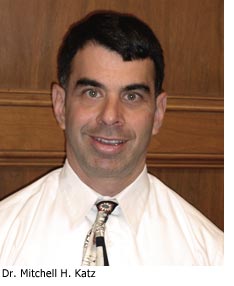 Katz, who will earn $355,000 a year in L.A., was recruited to come here two years ago but declined, citing unfinished work in San Francisco. That included seeing through the implementation of the award-winning Healthy San Francisco, a voluntary universal healthcare program that provides coverage to more than 54,000 people.
Katz, who will earn $355,000 a year in L.A., was recruited to come here two years ago but declined, citing unfinished work in San Francisco. That included seeing through the implementation of the award-winning Healthy San Francisco, a voluntary universal healthcare program that provides coverage to more than 54,000 people.
Making the move now, he said, just “feels right.” Many in the Los Angeles County Health Department, which is battling a large deficit and has not had a permanent leader for more than two years, have reached out to him by phone or email since his appointment, offering to do “everything they can to help me,” Katz said.
While Katz believes L.A. and San Francisco are far from polar opposites from a health care perspective—“I think they are more alike than different”—he knows that his management approach will have to change somewhat when he makes the move.
“I’m a very hands-on person,” Katz said. “I know every single health center in San Francisco that’s part of my department. Most of them I’ve actually worked in as a doctor. I can bicycle to any of them.”
In L.A., “I have to think of a completely different way to be. You can’t do a lot of walking around when it takes two hours to drive somewhere.”
The county’s vast sprawl can be even more daunting if you’re a self-described bad driver.
“I’m terrible!” Katz said. “It’s certainly going to be a challenge to me.”
Katz, a committed bicycle commuter in San Francisco, said he can often be seen pedaling around town in tie and jacket, his backpack stuffed with papers. “It’s not unusual,” he said, “for someone to yell out, ‘Hi, Dr. Katz!’ “
After he moves to L.A. in January (his partner, Igael Gurin-Malous, a teacher, and their kids Maxwell, 8, and Roxie, 6, will join him when the school year is over) Katz intends to continue his cycling ways.
He’s looking for a house in a neighborhood, perhaps Silver Lake or Los Feliz, that’s within biking distance of his new office and County-USC Medical Center. He knows he will need to get behind the wheel to get to more far-flung hospitals such as Olive View-UCLA Medical Center in Sylmar. “I’ll just have to do it,” he said.
But he doesn’t sound like he’s planning to become a Southern California car culture convert any time soon.
“I do not love cars,” he said. “I think that the world would be a better place if more people bicycled.”
Posted 10/25/10
Let the meeting come to you
November 4, 2010
Interested in keeping up with important decisions affecting the environment and land use in L.A. County? Regional Planning Commission meetings are now just a mouse click away. It’s no longer necessary to dig through pages of transcripts to see what happened, and you won’t need to make a long trek across town to show up in person, either. Beginning this week, live and recorded Regional Planning meetings will be available online, in living color, at http://planning.lacounty.gov/video.
The Regional Planning Commission covers many issues that affect residents in unincorporated areas of the Third District. Upcoming decisions include adopting a new general plan for Los Angeles County, which will literally shape unincorporated communities for generations to come. It will affect how much development will occur in sensitive natural environments countywide, as well as developments affecting individual neighborhoods from Topanga Canyon to Universal City.
Systems analyst Dennis Slavin spearheaded the effort to update the technology of the meeting room and offer a bird’s-eye view of the meetings to the public. His goal was to make it easier for residents to participate, and to improve the transparency and efficiency of the process. When he took on the project, the room’s technology had not been updated in nearly a half-century. Presentations involved paper maps that were difficult to see even for those present at the meetings. Now, “meetings include visual presentations and GIS mapping, a full production that will provide a quality presentation to the public,” Slavin says.
In addition to streaming video of the meeting, the webcasts also allow viewers to get a close-up look at materials being presented and to access documents like the meeting agenda from the same screen.
You can sample the new technology by tuning in to the next commission meeting, on Wednesday, November 10.
Posted 11/4/10
Fresh start for failed youth camp school
November 4, 2010
Less than a year after a class action lawsuit alleged a near-total breakdown in the school system at the county’s largest juvenile detention camp, the Board of Supervisors has approved a far-reaching settlement that will overhaul educational services at the Challenger Memorial Youth Center in Lancaster.
Under the agreement negotiated with a coalition of civil rights groups and approved Wednesday, the complex of six probation camps colloquially known as “Camp Challenger” will have up to a year to vastly upgrade an educational system that has been beset for several years by accusations of incompetence and disregard.
Among other things, the camp, which is required by law to provide schooling to some 650 students, will be forced to hire reading specialists and create vocational and literacy programs for its charges, many of whom arrive with reading skills that are several years behind grade level. Also among the mandates are improvements in access to books and workspaces, a designated classroom for kids in the facility’s special handling unit, an updated security system and improved monitoring of teacher absences.
A panel of nationally-known educational experts will develop and monitor the reforms at the institution. Intensive tutoring also will be made available to students who were at Challenger after 2008, the parties said.
“Los Angeles is going to be a national model,” said Mark Rosenbaum, chief counsel of the ACLU of Southern California, which brought the class action along with Public Counsel and the Disability Rights Legal Center on behalf of three youths who had been held at Challenger as minors.
“While we do not acknowledge that all the allegations are true, we did recognize there were some serious problems and this lawsuit brought it to everyone’s attention,” agreed Assistant County Counsel Roger Granbo, who negotiated on behalf of the county. “There’s going to be a complete culture change out at Challenger.”
The suit, filed in January against the probation department and the Los Angeles County Office of Education, had depicted educational negligence at Challenger in epic proportions—a years-long situation in which teachers were routinely AWOL, kids lacked textbooks, pleas for educational help were ignored or punished and at least one teenager who had been at Challenger for most of his adolescence was awarded a diploma, even though he was illiterate.
One teenager allegedly spent months in a solitary cell with no schooling except for occasional meetings with a teacher who sometimes left after as little as 15 minutes. Classwork, the suit claimed, consisted of occasional worksheets thrown under the cell door. Another said he was denied special instruction even though, at 17, he had the reading comprehension of a second grader and had repeatedly told his teachers he didn’t understand the classwork.
The suit alleged that students were so illiterate that they could not complete job applications or read restaurant menus. “These kids were regarded as disposable people,” Rosenbaum says.
Situated in the desert next to a prison, the Challenger complex has suffered from its remote location, as well as architecture that imparts a forbidding, prison-like atmosphere, even without the punitive culture and hostility that have plagued it in recent years, educational experts say. Allegations of mistreated teenagers there made it the target of a Department of Justice investigation, and a 2009 Los Angeles County Probation Commission report called its school system “broken.”
However, both sides said, the settlement promises to address longstanding concerns in and outside the probation system, and retirements and resignations in recent months have turned over leadership at both the county probation department and the office of education.
“Already we’re seeing changes at Challenger,” said Cal Remington, chief deputy of the probation department. “There’s a new principal I have a lot of confidence in, and he’s already making a difference. And we’ve already brought in some experienced teachers from other institutions.”
Rosenbaum praised the county for seizing on the lawsuit as an opportunity to push for more change. “This was a cooperative venture from the beginning — all the energy was toward finding a solution for the kids,” he said.
And experts in the rehabilitation of juvenile offenders said that even at an institution like Challenger, teachers and programs can make a difference.
“You can blame the kids, you can blame the architecture, you can say the place is in the desert far from home,” said University of Maryland education professor Peter Leone.
“But I’ve seen some correctional settings that were really unappealing and they have some terrific programs. Look, we’re the adults in this situation. If we teach kids begrudgingly and don’t inspire within them the spark of learning, we have no one to blame but ourselves.”
Although the county and the ACLU have agreed to the settlement, it will not be finalized until the court signs off.
Posted 11/4/10
Touring Hall of Justice, by flashlight
November 3, 2010
The temperature outside was pushing 90, but when the padlock came off the chained doors of the Hall of Justice, the air rushed out like a chilly blast from the crypt.
Inside, though, the legendary 1925 building looks like it’s starting to wake up from its big sleep.
The Hall of Justice—where Charles Manson, Bugsy Siegel, Sirhan Sirhan and a host of other big- and small-time criminals once cooled their heels, where Marilyn Monroe’s body ended up after her suicide and where Robert Mitchum once did time for marijuana possession—is one of downtown’s Los Angeles’ most striking landmarks.
Red-tagged and vacant since the 1994 Northridge earthquake, the Hall not so long ago was rat-infested, debris-ridden and home to the occasional transient.
Now its interior has been cleaned out and virtually gutted.
Later this month, the county Board of Supervisors will be asked to approve the selection of a firm to undertake the historic rehabilitation and retrofitting that will turn the site into the new headquarters for the Sheriff’s Department. Staff from the District Attorney, Public Defender and Alternate Public Defender also will be stationed in the building, located at Spring and Temple, across from the criminal courts building.
Work on the three-year project is expected to begin early next year. The approximately $244 million Hall of Justice rehabilitation, along with other capital projects, will be funded in part by “Build America” bonds whose issuance was approved by supervisors on Wednesday. The project’s cost is expected to be partly offset by lease savings for the departments that will be relocating to the building.
Alicia Ramos, who has been overseeing the Hall of Justice project for the county Department of Public Works since 2004, said that years of advance work have been devoted to “trying to create the cleanest slate we can” for the new office space interior.
On Tuesday, Ramos led a writer for Supervisor Yaroslavsky’s website and a county photographer on a flashlight-illuminated tour that started in the building’s basement and ended on its rooftop. A gallery of photos from the tour, below, offers an unusual glimpse inside the building as it awaits its transformation.
To get to this point, tons of debris—including about a half million dollars’ worth of recycled jail cell bars—have been hauled away and reams of once-confidential documents have been incinerated and sent to that great repository in the sky. (See update below.) Elevator shafts now stand empty, their vintage wood-and-brass cabs sidelined until they can be pressed back into service with a modern operating system.
All of the building’s jail cells have been ripped out. One cell block, said to have housed Manson, has been preserved and relocated to the first floor, where it eventually will be opened to the public as part of a new museum/interactive center focused on the history of the building and the sheriff’s department.
The building’s courtrooms, once the site of trials that included the Sleepy Lagoon murder case, have all been demolished except for one, which is being preserved right down to its embellished plaster corbels and will be restored and used as a sheriff’s conference room. The same goes for a wood-paneled law library nearby. Both are located on the building’s 8th floor, where the sheriff will have his office.
The plan to bring the Hall of Justice back to life includes seismic reinforcement; new electrical, plumbing and mechanical systems; a 1st floor cafeteria that will be open to the public; and a nine-level, 1,000-vehicle parking structure, half of it underground.
The building’s open lobby, or loggia—which Ramos calls “the crowning glory of the Hall of Justice’—also is awaiting restoration. Even in its current state, the loggia exudes glamour and gravitas, from its marble columns to its elaborate ceiling and chandeliers. Covered up for the moment are its terrazzo floors and historic iron-and-brass stairs.
“It’s dramatic. It’s the scale, it’s the materials,” said Ramos, 37, an architect and Cal Poly Pomona grad. “It really can take you back to a period.”
Even in its current state, the Hall—whose architectural style is variously described as Beaux Arts, Italian Renaissance or Federalist—holds no terrors for Ramos, despite its sometimes macabre past.
“I haven’t gotten any ghost stories out of this building,” she said. Those she’s heard from others can be logically explained. (Voices in the basement, for instance, are more likely coming via a closed-up tunnel from an adjoining county building, not from the spirit world beyond.)
“They’re all stories to me. I’ve never seen anything wicked or sinister,” Ramos said.
She even ventured inside the Hall alone occasionally, like the time she came inside to photograph a judicial seal inside the law library.
Later, she was there when a transient who’d been caught living in the building was escorted away by police.
The man looked at Ramos. “He said, ‘I know you. I’ve seen you walking through here.’ The hair went up on my neck.”
Nowadays, she said, “I don’t go through the building by myself.”
Up on the building’s roof—once a prison yard-style exercise area for inmates that may be turned into a jogging track for employees—Ramos reflected on everyone and everything these walls have seen.
“Between Marilyn Monroe and Charlie Manson,” she said, “it’s kind of the good and the bad that come through these kinds of facilities.”
Photos by Scott Harms/Los Angeles County
Posted 11/3/10
Updated 11/4: Regarding questions about the destruction of documents, sheriff’s officials said Thursday that they removed all records from the Hall of Justice and left behind only trash or outdated forms. Department of Public Works officials said they exercised an abundance of caution and treated all papers left behind as confidential because they were not in a position to evaluate them. They said all documents were destroyed in accordance with the county’s policy.
DCFS data collection called “colossal mess”
November 3, 2010
Two weeks ago, in an effort to find possible trends in the tragic deaths of youngsters who’d come to the attention of Los Angeles County child welfare officials, the Board of Supervisors asked for data on fatalities dating back two decades.
.
On Wednesday, however, a clearly angry Supervisor Zev Yaroslavsky said the board would be lucky to get useful information from just two years ago, calling the data collection efforts of the Department of Children and Family Services “a colossal mess.”
Yaroslavsky said the Chief Executive Office has expressed concerns that the historical information may not even be available. This, Yaroslavsky said, “begs the question: What is the Department of Children and Family Services basing any of its policies on when it comes to protecting children’s lives?”
The supervisor’s remarks came during yet another debate—and more motions—involving the performance of DCFS, which has come under withering criticism in the wake of numerous child deaths and the department’s failure to publicly disclose some of them.
One of the motions, approved by the board during its Wednesday meeting, called for a single county entity to track and compile information on child deaths related to abuse or neglect. Another motion called for the reversal of the board’s earlier request for 20 years of fatality data in the belief that it’s better to look forward than back.
But the board majority disagreed. Supervisor Mark Ridley-Thomas, who had co-authored the motion for historical information with colleague Michael D. Antonovich, said that without such data, “the best you do is find yourself being driven by the anecdotal rather than analytical.”
Acting on a compromise suggested by Yaroslavsky, the board scaled back its request to10 years. Although the department may be unable to generate even that data, Yaroslavsky said, the effort should still be aggressively pursued in the spirit of transparency for a public that “is livid” with the county, from the top down.
If the information isn’t available, then “the public ought to know that the Department of Children and Family Services can’t respond to that kind of fundamental question,” he said. “But to just pull out and say, ‘Never mind. We don’t really want to do that,’ is not the way I want to do business.”
He added: “I think we should stop being defensive about this and just let the chips fall where they may.”
Posted 11/3/10
State wins billions in needed federal health aid
November 3, 2010
 After more than a year of tortuous negotiations between state and federal health officials, it was announced this week that California will receive $10 billion in health aid during the next five years through the renewal of its ongoing Medicaid waiver.
After more than a year of tortuous negotiations between state and federal health officials, it was announced this week that California will receive $10 billion in health aid during the next five years through the renewal of its ongoing Medicaid waiver.
The infusion of new federal funding will expand health coverage for uninsured low-income residents, improve access and quality of care for seniors and the disabled, and help implement federal health care reform when its new rules take effect in 2014.
The negotiations took place between the Centers for Medicaid and Medicare Services and California’s Department of Health and Human Services.
The County of Los Angeles—constituting roughly 30% of the state’s population but 34% of the state’s medically indigent and 36% of those living below the federal poverty level—will be a major beneficiary of the aid. Those funds have helped to underwrite the County’s continuing reform and restructuring efforts since 1995, when the Clinton Administration granted the initial five-year federal waiver under Section 1115(a) of the Social Security Act.
That waiver allowed Los Angeles County to reconfigure its health-care services, creating public-private partnerships with non-profit community-based clinics and expanding ambulatory and outpatient services with federal money. This was accomplished by “waiving” federal requirements that had restricted the funding to reimbursement for in-patient hospital services, the costliest type of medical care.
To learn more about the recently approved agreement, formally known as California’s “Bridge to Reform: A Section 1115 Waiver Proposal,” visit the California Department of Health Care Services site here.
Posted 11/03/10
Changing of the guard at Watts Towers
November 3, 2010
Minding a masterpiece isn’t easy. The Watts Towers have been among Los Angeles’ great public treasures, but their upkeep has been a full-time challenge almost since they were finished in 1954.
Rattled by earthquakes, assaulted by rainstorms, the fantastic, filigreed metropolis erected by an Italian-born amateur stonemason in a South-Central barrio is perpetually in a state of deterioration. The mortar cracks. The tiles are forever falling. The joints are damp with seepage and rusting from within.
Late last month, the Los Angeles County Museum of Art announced plans to lend a hand to the recession-slammed city in ensuring that Simon Rodia’s renowned public sculpture is preserved. The art world is applauding the one-year agreement, in which LACMA will contribute expertise, staff and — most crucially — fundraising assistance.
And cheering the loudest are Zuleyma Aguirre and Virginia Kazor.
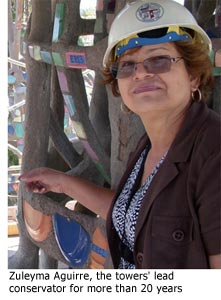 For some 20 years, Aguirre and Kazor have tended the towers. Before her retirement this summer, Kazor spent 19 years as the historic site curator, managing the conservation effort for the city’s cultural affairs department. Aguirre, her lead conservator, handled all the on-site restoration, tending every inch of concrete, tile and metal until she was sidelined two years ago by an injury on the job.
For some 20 years, Aguirre and Kazor have tended the towers. Before her retirement this summer, Kazor spent 19 years as the historic site curator, managing the conservation effort for the city’s cultural affairs department. Aguirre, her lead conservator, handled all the on-site restoration, tending every inch of concrete, tile and metal until she was sidelined two years ago by an injury on the job.
Together, the two women – one an art historian raised in Los Angeles, the other an El Salvador-born expert in the restoration of pre-Columbian artifacts – have shepherded the landmark through the Los Angeles riots, the Northridge earthquake and countless storms and budget woes. This week, they sat down with ZevWeb to talk about the labor of love that became not only Simon Rodia’s life’s work, but theirs as well.
“The first time I came to the towers,” Aguirre remembers, “it was 1988. They were just – oh! Amazing! Rodia’s work made me feel like I really had not done too much in the world.”
She had come to the United States in the early ‘80s on a grant to visit museums, and remained, reluctant to return to her country’s civil war. The Watts job became hers after she hired on with a city consultant working on the towers’ preservation. The project, she immediately realized, would be like no other.
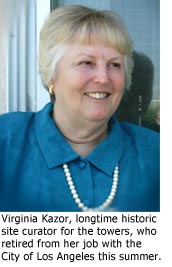 “I had come from working in museums,” she says, “and the towers were just so different. There were no drawings we could find, no blueprints. We had to do X-rays to learn how he did the connections on 5,000 joints.”
“I had come from working in museums,” she says, “and the towers were just so different. There were no drawings we could find, no blueprints. We had to do X-rays to learn how he did the connections on 5,000 joints.”
In 1991, Kazor became Aguirre’s supervisor on the project. Already a longtime curator for the city, her relationship with the towers was more than three decades old. As a student in 1958 at the University of Southern California, she had been assigned to report on them by her design teacher.
“I was so fascinated that after that, when I met someone and found him interesting, I’d always take him first to the Watts Towers,” she remembers, laughing. “And if — and only if — they liked them, then I’d go out with them.”
Then and now, she says, she was moved by the assemblage – a collection of 17 structures, built over 33 years by an eccentric handyman. Constructed by hand out of scraps and castoffs, the towers’ famed spires soar up to 99 feet over their impoverished surroundings.
Kazor, who was diagnosed with Parkinson’s shortly after being assigned to Rodia’s project, connected with the resolve that fueled it: “They’re ours and they’re absolutely unique. And they are a testament to what one person can accomplish, if they just set their minds to it.”
That determination, the women say, was what most impressed them, day after workday.
“Rodia was a common laborer who took part-time jobs,” Kazor says, “but he was sort of intuitively brilliant. He took any steel he could find — rebar if it was available, but he’d use water pipe or anything he thought would work.
“And he didn’t weld. He overlapped the pieces, wrapped the overlapped portion with wire to hold them together, and then covered that with chicken wire. Then he took a very dry concrete mix — you could pick it up by the handful and it would hold its shape — and he’d press that into the chicken wire. Then he would press into that the decorative elements he had chosen. Seashells or tile or the impression of a tool or broken glass.”
But his work didn’t end there. “After that, he would have to keep the concrete moist by spraying it with water for more than a week,” Kazor says. “And he did this by climbing up the towers as if they were scaffolding. And he would carry on his arm a bucket with whatever materials he needed. And every time he needed more materials, he had to go all the way back down to the ground and then all the way back up again.”
Honoring that artistic commitment has required its own brand of determination. After every Santa Ana wind or winter rainstorm, tile and bits of concrete shower from the structures onto the ground. Moisture is a constant challenge.
“Once water gets past the decorative surface and through the concrete, the steel inside it rusts,” says Kazor. “And then the rust expands. And the cracks get larger, and more water gets in, and eventually the interior steel structure rusts away.”
Part of Aguirre’s job, she says, was to walk the site with her crew daily, picking up fragments and carefully documenting where they had fallen and where they belonged.
“Early on in the project, the whole structure was completely photographed, and broken down into a 4-foot grid,” says Kazor. “So each worker, every day, would be assigned a certain area, and at the end of the day, record what he did there.”
That painstaking documentation, she says, has been the key to FEMA and other grants that have underwritten tower restoration again and again.
The work hasn’t always been safe.
“Once,” Kazor says, “one of our construction workers was on the scaffolding 40 feet in the air, and an earthquake hit. And he said, ‘Please don’t fire me, but the scaffolding was shaking so hard, I had to hang onto the tower.’ When he looked down, he said, he could see the wave of the earthquake come down the street, lifting the backs of the parked cars.”
In fact, Aguirre has been unable to work for more than two years, after having been struck by a piece of scaffolding that damaged two cervical vertebrae in 2008. It was not her first on-the-job injury. In 2001, she says, she was mugged as she arrived for work early one morning, carrying her purse and her laptop.
“This young fellow asked me for the time, and when I didn’t know, he went with his fist in my face,” Aguirre remembers. The blow broke six of her teeth and severed an artery, and Kazor says Aguirre nearly bled to death before she was found.
Yet for all the challenges, the women say, the towers have been deeply rewarding.
“It’s magic there,” says Aguirre. “I felt I could hear Rodia’s steps some days, when everybody went to lunch and I stayed there alone. From the top, you can see all over the city. It’s gorgeous. You have a whole other vision of Watts. Or just sitting there below, looking up. Hearing all the Watts sounds. The neighbor sounds – the rap, the Mexican music, the lambada, the smell of the materials. The mix. Everywhere you look, it is art.”
This fragile, unconventional beauty, Kazor says, is why LACMA’s involvement is so welcome.
“The city does not really have the resources any more to do what needs to be done,” she says, noting that by the time she retired, the manpower the city had committed to the towers had fallen from about 14 full- and part-time workers to two.
“The Watts Towers are as important as any work in a museum. They are like the Eiffel Tower, or the Millennium Wheel in London. They’re a great gift to Los Angeles.”
Watch this short film on the Towers

Posted 10/28/10





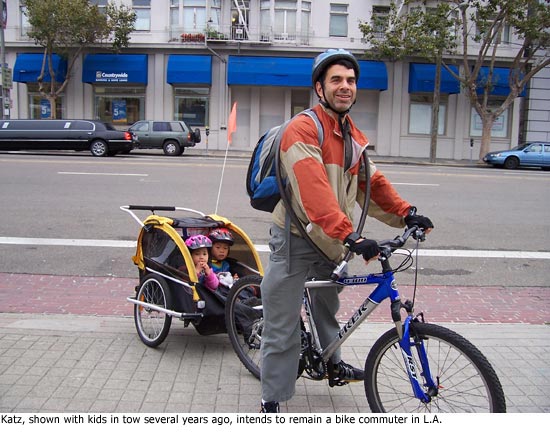
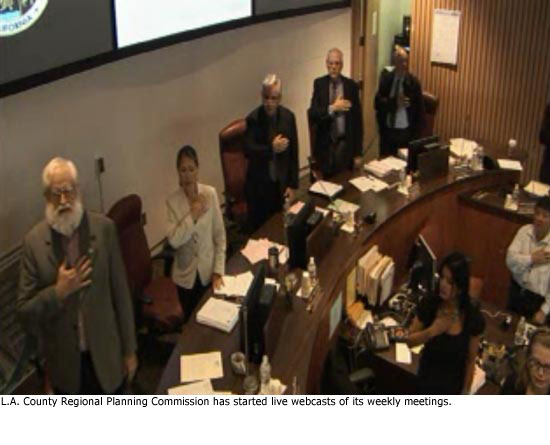
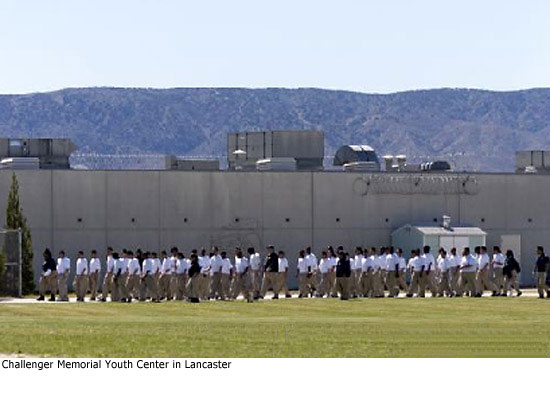
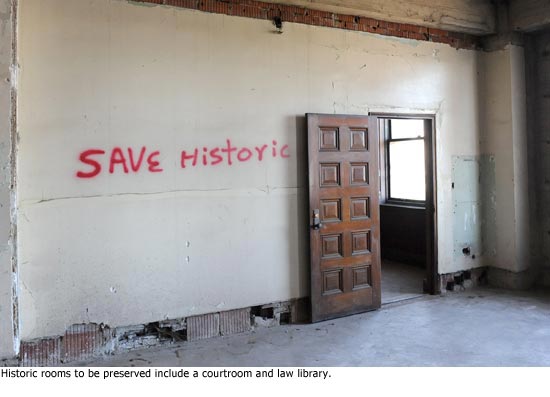
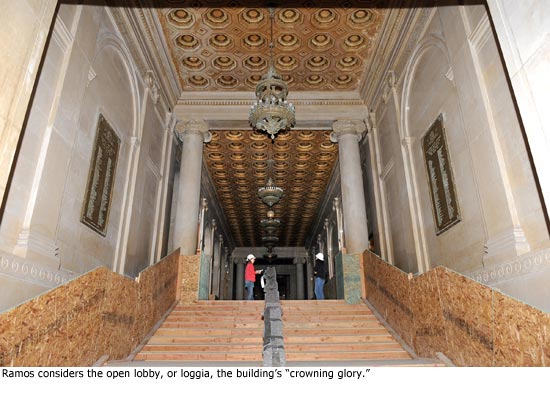















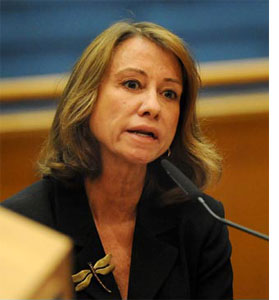

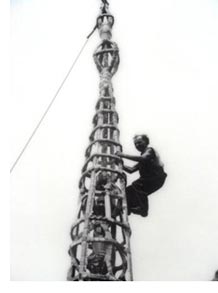





 Check for the latest closure information
Check for the latest closure information








